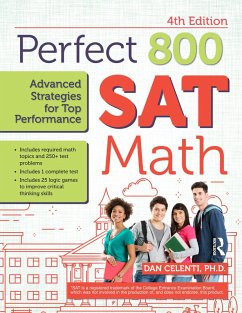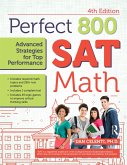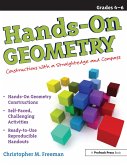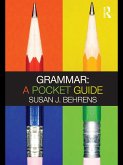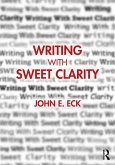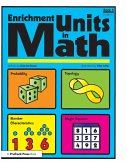

Alle Infos zum eBook verschenken

- Format: ePub
- Merkliste
- Auf die Merkliste
- Bewerten Bewerten
- Teilen
- Produkt teilen
- Produkterinnerung
- Produkterinnerung

Hier können Sie sich einloggen

Bitte loggen Sie sich zunächst in Ihr Kundenkonto ein oder registrieren Sie sich bei bücher.de, um das eBook-Abo tolino select nutzen zu können.
Getting into the nation's most competitive universities requires more than a good SAT score-it requires a perfect score. Perfect 800: SAT Math :
Gives advanced students the tools needed to master the SAT math test. | Includes 250+ problems, two complete practice tests, and 25 logic games. | Covers arithmetic concepts, algebra, geometry, trigonometry, and more. | Emphasizes critical thinking and analytic skills over memorization and trial and error.
This updated 2021 edition offers exposure to a wide range of degrees of difficulty in a holistic approach that allows students to…mehr
- Geräte: eReader
- mit Kopierschutz
- eBook Hilfe
![Perfect 800 (eBook, PDF) Perfect 800 (eBook, PDF)]() Dan CelentiPerfect 800 (eBook, PDF)21,95 €
Dan CelentiPerfect 800 (eBook, PDF)21,95 €![Hands-On Geometry (eBook, ePUB) Hands-On Geometry (eBook, ePUB)]() Christopher M. FreemanHands-On Geometry (eBook, ePUB)17,95 €
Christopher M. FreemanHands-On Geometry (eBook, ePUB)17,95 €![Grammar: A Pocket Guide (eBook, ePUB) Grammar: A Pocket Guide (eBook, ePUB)]() Susan J. BehrensGrammar: A Pocket Guide (eBook, ePUB)21,95 €
Susan J. BehrensGrammar: A Pocket Guide (eBook, ePUB)21,95 €![Writing with Sweet Clarity (eBook, ePUB) Writing with Sweet Clarity (eBook, ePUB)]() John E. EckWriting with Sweet Clarity (eBook, ePUB)21,95 €
John E. EckWriting with Sweet Clarity (eBook, ePUB)21,95 €![Beyond Base Ten (eBook, ePUB) Beyond Base Ten (eBook, ePUB)]() Dana T. JohnsonBeyond Base Ten (eBook, ePUB)31,95 €
Dana T. JohnsonBeyond Base Ten (eBook, ePUB)31,95 €![Enrichment Units in Math (eBook, ePUB) Enrichment Units in Math (eBook, ePUB)]() Dianne DrazeEnrichment Units in Math (eBook, ePUB)15,95 €
Dianne DrazeEnrichment Units in Math (eBook, ePUB)15,95 €![The Complete Classroom (eBook, ePUB) The Complete Classroom (eBook, ePUB)]() Steven HastingsThe Complete Classroom (eBook, ePUB)25,95 €
Steven HastingsThe Complete Classroom (eBook, ePUB)25,95 €-
-
-
- Gives advanced students the tools needed to master the SAT math test.
- Includes 250+ problems, two complete practice tests, and 25 logic games.
- Covers arithmetic concepts, algebra, geometry, trigonometry, and more.
- Emphasizes critical thinking and analytic skills over memorization and trial and error.
This updated 2021 edition offers exposure to a wide range of degrees of difficulty in a holistic approach that allows students to experience the "real thing," including the impact of time constraints on their performance. This book ensures optimal usage of time and maximizes the pace of progress as students prepare for the all-important test.
The book contains one complete practice test and a second practice test is downloadable from www.routledge.com/9781646321049.
Grades 9-12
Dieser Download kann aus rechtlichen Gründen nur mit Rechnungsadresse in A, B, BG, CY, CZ, D, DK, EW, E, FIN, F, GR, HR, H, IRL, I, LT, L, LR, M, NL, PL, P, R, S, SLO, SK ausgeliefert werden.
- Produktdetails
- Verlag: Taylor & Francis eBooks
- Seitenzahl: 396
- Erscheinungstermin: 7. September 2021
- Englisch
- ISBN-13: 9781000495133
- Artikelnr.: 62536704
- Verlag: Taylor & Francis eBooks
- Seitenzahl: 396
- Erscheinungstermin: 7. September 2021
- Englisch
- ISBN-13: 9781000495133
- Artikelnr.: 62536704
- Herstellerkennzeichnung Die Herstellerinformationen sind derzeit nicht verfügbar.
SAT Book This Book's Approach PART I: GENERAL TEST-TAKING ADVICE AND
STRATEGIES Chapter 1: What Is Math and Why Do I Need to Study It? Why You
Should Never Say "I Hate Math!" Chapter 2: Test Preparation Strategies and
Advice How Too Much "Strategy" Can Be Hazardous to Your Performance An
Approach to Test Preparation Do Calculators Really Help? Too Much
Memorization? Ubiquitous Algebra Fast Math Reading Comprehension PSAT
Versus SAT SAT Versus ACT Final Tips for Better Learning PART II: SPECIFIC
MATH TOPICS, TIPS FOR PROBLEM SOLVING, AND SAMPLE PROBLEMS Chapter 3:
Arithmetic Concepts 3.1: Integer 3.2: Odd/Even Numbers 3.3: Consecutive
Integers 3.4: Number Line 3.5: Reciprocal (of a Number) 3.6: Factors (of a
Number) 3.7: Common Factors 3.8: Greatest Common Factor (GCF) 3.9: Common
Multiples (of Two or More Numbers) 3.10: Least Common Multiple (LCM) 3.11:
Greatest Common Divisor (GCD) 3.12: Prime Numbers 3.13: Ratio 3.14: Percent
3.15: Proportion 3.16: Directly Proportional Quantities 3.17: Inversely
Proportional Quantities 3.18: Sequence 3.19: Arithmetic Sequence 3.20:
Geometric Sequence 3.21: Set 3.22: Union 3.23: Intersection 3.24: Venn
Diagram 3.25: Factorials 3.26: The Fundamental Counting Principle 3.27:
Permutation 3.28: Combination 3.29: Distinguishable Permutations 3.30:
Absolute Value Chapter 4: Algebra 4.1: Monomial 4.2: Coefficient 4.3:
Polynomial 4.4: Term 4.5: Like Terms 4.6: Exponents 4.7: Function 4.8:
Quadratic Function 4.9: Domain 4.10: Range 4.11: Interpreting and Solving
Equations/Inequalities 4.12: Cartesian Coordinate System 4.13: Straight
Line 4.14: Slope 4.15: Distance 4.16: Midpoint 4.17: Graphical
Representation of Inequalities 4.18: Complex Numbers Chapter 5: Geometry
5.1: Angles 5.2: Vertex 5.3: Acute Angles 5.4: Obtuse Angles 5.5: Vertical
Angles 5.6: Supplementary Angles 5.7: Complementary Angles 5.8: Straight
Angles 5.9: Right Angles 5.10: Exterior Angles 5.11: Polygon 5.12: Diagonal
5.13: Triangle 5.14: Acute Triangle 5.15: Obtuse Triangle 5.16: Right
Triangle 5.17: Equilateral Triangle 5.18: Isosceles Triangle 5.19:
Hypotenuse 5.20: Congruent Triangles 5.21: Similar Triangles 5.22: Altitude
5.23: Quadrilaterals 5.24: Parallelograms 5.25: Rectangles 5.26: Squares
5.27: Perimeter 5.28: Regular Polygon 5.29: Circle 5.30: Diameter 5.31:
Radius 5.32: Arc 5.33: Tangent Line 5.34: Tangent to a Circle 5.35:
Circumference 5.36: Central Angle 5.37: Area of a Sector and Arc Length
5.38: Solid Geometry Chapter 6: Trigonometry 6.1: Right Triangle 6.2: Unit
Circle 6.3: Degrees to Radians Conversion 6.4: Trigonometric Functions 6.5:
Miscellaneous Identities 6.6: Pythagorean Identities Chapter 7:
Miscellaneous Topics 7.1: Average/Arithmetic Mean 7.2: Median 7.3: Mode
7.4: Weighted Average 7.5: Probability 7.6: Probability and Compound Events
7.7: Elements of Statistics Chapter 8: Problems by Degree of Difficulty and
Type 163 8.1: Easy Problems; Multiple Choice 8.2: Easy Problems; Open-Ended
8.3: Medium Problems; Multiple Choice 8.4: Medium Problems; Open-Ended 8.5:
Hard Problems; Multiple Choice 8.6: Hard Problems; Open-Ended Chapter 9:
Solutions to Problems in Chapter 8 Chapter 10: Additional Problems Chapter
11: Solutions to Problems in Chapter 10 Chapter 12: Mind Games Chapter 13:
Solutions to Mind Games Chapter 14: Test Yourself Conclusion Appendix A
Appendix B: Solutions to On Your Own Problems References About the Author
Common Core State Standards Alignment
SAT Book This Book's Approach PART I: GENERAL TEST-TAKING ADVICE AND
STRATEGIES Chapter 1: What Is Math and Why Do I Need to Study It? Why You
Should Never Say "I Hate Math!" Chapter 2: Test Preparation Strategies and
Advice How Too Much "Strategy" Can Be Hazardous to Your Performance An
Approach to Test Preparation Do Calculators Really Help? Too Much
Memorization? Ubiquitous Algebra Fast Math Reading Comprehension PSAT
Versus SAT SAT Versus ACT Final Tips for Better Learning PART II: SPECIFIC
MATH TOPICS, TIPS FOR PROBLEM SOLVING, AND SAMPLE PROBLEMS Chapter 3:
Arithmetic Concepts 3.1: Integer 3.2: Odd/Even Numbers 3.3: Consecutive
Integers 3.4: Number Line 3.5: Reciprocal (of a Number) 3.6: Factors (of a
Number) 3.7: Common Factors 3.8: Greatest Common Factor (GCF) 3.9: Common
Multiples (of Two or More Numbers) 3.10: Least Common Multiple (LCM) 3.11:
Greatest Common Divisor (GCD) 3.12: Prime Numbers 3.13: Ratio 3.14: Percent
3.15: Proportion 3.16: Directly Proportional Quantities 3.17: Inversely
Proportional Quantities 3.18: Sequence 3.19: Arithmetic Sequence 3.20:
Geometric Sequence 3.21: Set 3.22: Union 3.23: Intersection 3.24: Venn
Diagram 3.25: Factorials 3.26: The Fundamental Counting Principle 3.27:
Permutation 3.28: Combination 3.29: Distinguishable Permutations 3.30:
Absolute Value Chapter 4: Algebra 4.1: Monomial 4.2: Coefficient 4.3:
Polynomial 4.4: Term 4.5: Like Terms 4.6: Exponents 4.7: Function 4.8:
Quadratic Function 4.9: Domain 4.10: Range 4.11: Interpreting and Solving
Equations/Inequalities 4.12: Cartesian Coordinate System 4.13: Straight
Line 4.14: Slope 4.15: Distance 4.16: Midpoint 4.17: Graphical
Representation of Inequalities 4.18: Complex Numbers Chapter 5: Geometry
5.1: Angles 5.2: Vertex 5.3: Acute Angles 5.4: Obtuse Angles 5.5: Vertical
Angles 5.6: Supplementary Angles 5.7: Complementary Angles 5.8: Straight
Angles 5.9: Right Angles 5.10: Exterior Angles 5.11: Polygon 5.12: Diagonal
5.13: Triangle 5.14: Acute Triangle 5.15: Obtuse Triangle 5.16: Right
Triangle 5.17: Equilateral Triangle 5.18: Isosceles Triangle 5.19:
Hypotenuse 5.20: Congruent Triangles 5.21: Similar Triangles 5.22: Altitude
5.23: Quadrilaterals 5.24: Parallelograms 5.25: Rectangles 5.26: Squares
5.27: Perimeter 5.28: Regular Polygon 5.29: Circle 5.30: Diameter 5.31:
Radius 5.32: Arc 5.33: Tangent Line 5.34: Tangent to a Circle 5.35:
Circumference 5.36: Central Angle 5.37: Area of a Sector and Arc Length
5.38: Solid Geometry Chapter 6: Trigonometry 6.1: Right Triangle 6.2: Unit
Circle 6.3: Degrees to Radians Conversion 6.4: Trigonometric Functions 6.5:
Miscellaneous Identities 6.6: Pythagorean Identities Chapter 7:
Miscellaneous Topics 7.1: Average/Arithmetic Mean 7.2: Median 7.3: Mode
7.4: Weighted Average 7.5: Probability 7.6: Probability and Compound Events
7.7: Elements of Statistics Chapter 8: Problems by Degree of Difficulty and
Type 163 8.1: Easy Problems; Multiple Choice 8.2: Easy Problems; Open-Ended
8.3: Medium Problems; Multiple Choice 8.4: Medium Problems; Open-Ended 8.5:
Hard Problems; Multiple Choice 8.6: Hard Problems; Open-Ended Chapter 9:
Solutions to Problems in Chapter 8 Chapter 10: Additional Problems Chapter
11: Solutions to Problems in Chapter 10 Chapter 12: Mind Games Chapter 13:
Solutions to Mind Games Chapter 14: Test Yourself Conclusion Appendix A
Appendix B: Solutions to On Your Own Problems References About the Author
Common Core State Standards Alignment
